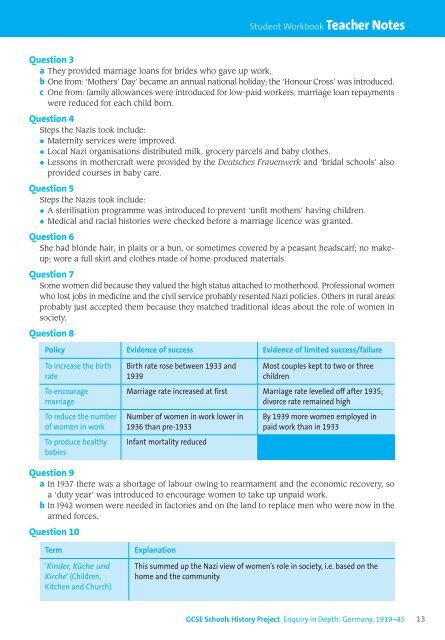<strong>GCSE</strong> <strong>Schools</strong> <strong>History</strong> <strong>Project</strong><strong>Enquiry</strong> <strong>in</strong> <strong>Depth</strong>: Germany, 1919–45Level 2: a simple comparison based on details <strong>in</strong> both sources, e.g. ‘Source A suggests that manypeople were <strong>in</strong>terested <strong>in</strong> pleasure cruises to foreign countries, but Source B po<strong>in</strong>ts out that mostcould not actually afford them.’Level 3: an answer based on a more developed understand<strong>in</strong>g of the differences between thesources, e.g. ‘Source A implies that KdF activities were provided for the good of the people andwere very popular. Source B suggests that these activities were really just a propaganda exerciseto w<strong>in</strong> people’s support and that the most attractive schemes were beyond the means of mostGermans.’Question 15Level 1: an answer that just describes differences between the sources.Level 2: an answer based on simple reasons l<strong>in</strong>ked to audience, author or publication date, e.g.‘Source A was written <strong>in</strong> the 1930s but Source B was written <strong>in</strong> the 1990s, so more could have beenknown about the KdF <strong>in</strong> the 1990s.’Level 3: an answer based on more developed reasons supported by additional knowledge,e.g. ‘Robert Ley was leader of the German Labour Front, so he would obviously have wanted tomake the KdF sound successful. Source B is from a textbook published many years later forstudents, so more <strong>in</strong>formation would have been available then and the author would have givena more objective assessment of the KdF.’Question 16Level 1: a simple answer that just describes what the source shows.Level 2: an answer l<strong>in</strong>k<strong>in</strong>g usefulness to Nazi economic policies, e.g. ‘Source C is useful becauseit shows a big drop <strong>in</strong> unemployment, so the Nazis’ economic policies must have been successful.’Level 3: background knowledge is used to show the limitations of the source, e.g. ‘Source Cshows that the Nazis’ aim of reduc<strong>in</strong>g unemployment was successful, but it does not tell usabout the success of their other aims, i.e. to build up Germany’s military strength and to becomeself-sufficient.’Question 17Level 1: simple statements supported by some knowledge.Level 2: more developed statements supported by relevant knowledge, but one-sided — eitherpositive or negative; e.g. either stress<strong>in</strong>g lower unemployment, improved work<strong>in</strong>g conditions, newleisure opportunities through the KdF or stress<strong>in</strong>g long hours, low pay, loss of union rights etc.Level 3: analysis based on a more balanced view supported by knowledge — ma<strong>in</strong>ly one-sided.Level 4: a susta<strong>in</strong>ed argument based on a balanced view, both sides well supported by knowledge,and reach<strong>in</strong>g a clear, supported conclusion.Topic 5 Women and the Church, 1933–45Question 1Possible answers <strong>in</strong>clude:• Women <strong>in</strong> top jobs, e.g. <strong>in</strong> the civil service and medic<strong>in</strong>e, were sacked.• In teach<strong>in</strong>g and the civil service, male applicants were given preference over females wherequalifications were equal.• After 1936, female judges and lawyers were barred from practis<strong>in</strong>g.Question 2The Nazis reduced the number of women <strong>in</strong> paid employment because:• They believed that a woman’s place was <strong>in</strong> the home.• They wanted women to have more children.• It would help reduce male unemployment.12
Student Workbook Teacher NotesQuestion 3a They provided marriage loans for brides who gave up work.b One from: ‘Mothers’ Day’ became an annual national holiday; the ‘Honour Cross’ was <strong>in</strong>troduced.c One from: family allowances were <strong>in</strong>troduced for low-paid workers; marriage loan repaymentswere reduced for each child born.Question 4Steps the Nazis took <strong>in</strong>clude:• Maternity services were improved.• Local Nazi organisations distributed milk, grocery parcels and baby clothes.• Lessons <strong>in</strong> mothercraft were provided by the Deutsches Frauenwerk and ‘bridal schools’ alsoprovided courses <strong>in</strong> baby care.Question 5Steps the Nazis took <strong>in</strong>clude:• A sterilisation programme was <strong>in</strong>troduced to prevent ‘unfit mothers’ hav<strong>in</strong>g children.• Medical and racial histories were checked before a marriage licence was granted.Question 6She had blonde hair, <strong>in</strong> plaits or a bun, or sometimes covered by a peasant headscarf; no makeup;wore a full skirt and clothes made of home-produced materials.Question 7Some women did because they valued the high status attached to motherhood. Professional womenwho lost jobs <strong>in</strong> medic<strong>in</strong>e and the civil service probably resented Nazi policies. Others <strong>in</strong> rural areasprobably just accepted them because they matched traditional ideas about the role of women <strong>in</strong>society.Question 8PolicyTo <strong>in</strong>crease the birthrateTo encouragemarriageTo reduce the numberof women <strong>in</strong> workTo produce healthybabiesEvidence of successBirth rate rose between 1933 and1939Marriage rate <strong>in</strong>creased at firstNumber of women <strong>in</strong> work lower <strong>in</strong>1936 than pre-1933Infant mortality reducedEvidence of limited success/failureMost couples kept to two or threechildrenMarriage rate levelled off after 1935;divorce rate rema<strong>in</strong>ed highBy 1939 more women employed <strong>in</strong>paid work than <strong>in</strong> 1933Question 9a In 1937 there was a shortage of labour ow<strong>in</strong>g to rearmament and the economic recovery, soa ‘duty year’ was <strong>in</strong>troduced to encourage women to take up unpaid work.b In 1942 women were needed <strong>in</strong> factories and on the land to replace men who were now <strong>in</strong> thearmed forces.Question 10Term‘K<strong>in</strong>der, Küche undKirche’ (Children,Kitchen and Church)ExplanationThis summed up the Nazi view of women’s role <strong>in</strong> society, i.e. based on thehome and the community<strong>GCSE</strong> <strong>Schools</strong> <strong>History</strong> <strong>Project</strong> <strong>Enquiry</strong> <strong>in</strong> <strong>Depth</strong>: Germany, 1919–4513
















